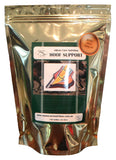 Seedy toe, stall rot, hoof wall disease, yeast infection, Candida, onychomycosis....whatever name it goes by, White Line Disease can make horses sore and can lead to severe lameness, abscessing and even bone erosion if left untreated. In extreme cases where the infection has run rampant through the foot, there may be no other choice than to euthanize the horse.
Seedy toe, stall rot, hoof wall disease, yeast infection, Candida, onychomycosis....whatever name it goes by, White Line Disease can make horses sore and can lead to severe lameness, abscessing and even bone erosion if left untreated. In extreme cases where the infection has run rampant through the foot, there may be no other choice than to euthanize the horse.
Multiple causes of White Line Disease have been proposed, including dampness, poor hygiene, infectious organisms, mechanical stress (long toe, high heels on a club foot) and vascular damage associated with laminitis. None of these factors however have been conclusively proven. White Line Disease is a widespread problem and affects horses and ponies of any age, sex or breed, both shod and barefoot.
White Line Disease is characterised by a progressive separation in the non-pigmented hoof wall, at the junction between the stratum medium (middle layer) and stratum internum (inner layer).
Dr. Stephen O'Grady describes White Line Disease as a "delaminating process potentially brought on from mechanical stress, environment conditions affecting the inner hoof wall attachment, and possibly some toxicity such as selenium" . He proposes that wall separation occurs first, followed by invasion of opportunistic bacteria and/or fungi, leading to infection.

A study from Japan also suggests a strong nutritional link in the incidence of White Line Disease. 100 performance riding horses were studied over a 5 year period. The study horses were divided into three groups. Groups A and B were the jumping and dressage horses, fed hay, alfalfa cubes and barley. These horses received timely shoeing, clean bedding and adequate hoof cleaning. However the incidence of White Line Disease in these horses was still high.
By contrast, Group C, the school horses went longer between shoeing, received inadequate hoof cleaning and had dirtier bedding. These environmental conditions often caused chipped hoof walls and thrush, but no White Line Disease. The crucial difference was in their diet. Instead of being fed barley like the two performance groups, the school horses were fed a pelleted feed to control exciteability. The great difference between the two diets was detected in copper and zinc contents: Group C was getting 12.4 mg/kg of copper compared to Groups A&B's intake of 6.6 mg/kg; and 55.6 mg/kg of zinc compared to 20.3 mg/kg.
Over the five year period, controlled changes to the diets of Groups A and B saw a significant decrease in the incidence of White Line Disease. The authors of the study concluded that "the present results strongly suggested that long term, not severe low-zinc and low-copper diets may cause a high risk of WLD in adult horses, and that an improved diet of these minerals may largely lead to the prevention of WLD" .
|
RELATED PRODUCTS |
|||
 |
 |
 |
 |
| Hoof Support | Hoof Builder | Lysine | Omega-3 |